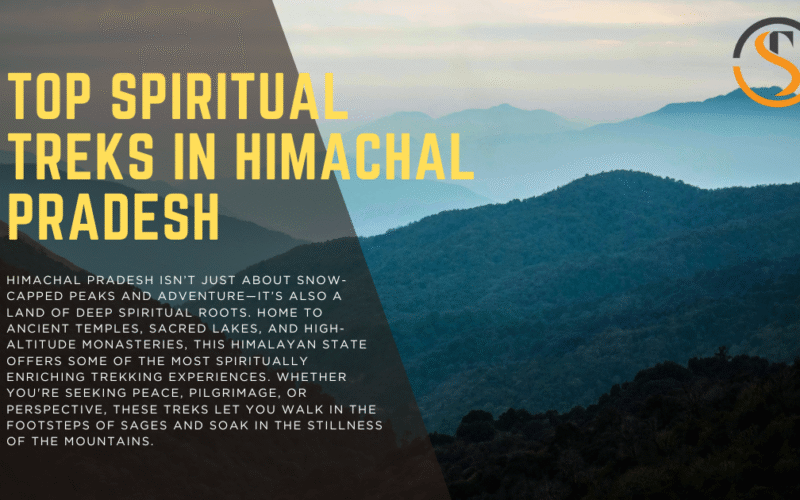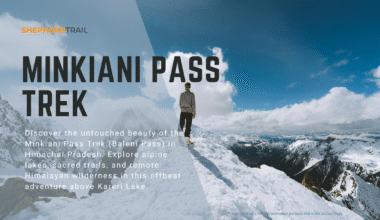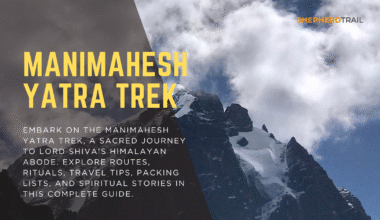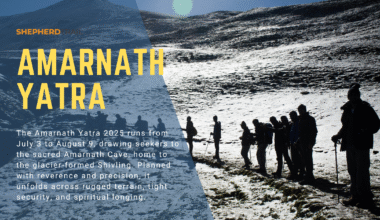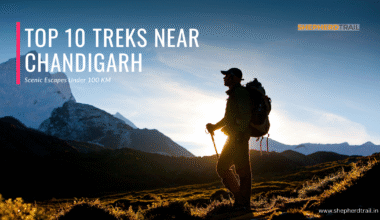Top Spiritual Treks for 2025 in Himachal Pradesh – A Soulful Journey in the Himalayas
Himachal Pradesh isn’t just about snow-capped peaks and adventure—it’s also a land of deep spiritual roots. Home to ancient temples, sacred lakes, and high-altitude monasteries, this Himalayan state offers some of the most spiritually enriching trekking experiences. Whether you’re seeking peace, pilgrimage, or perspective, these treks let you walk in the footsteps of sages and soak in the stillness of the mountains.
1. Kinner Kailash Trek
📍Location: Kinnaur District, Himachal Pradesh
✨ Introduction:
Considered one of the most sacred mountains in the Indian Himalayas, the Kinner Kailash trek is a revered journey for devotees of Lord Shiva. The trek leads you to a naturally formed 79-ft vertical Shivling rock that changes color throughout the day. According to mythology, Lord Shiva held meetings with the gods at this very spot.

🕰️ Best Time to Visit: July to September
🚩 Base Camp & How to Reach:
The trek begins from Tangling village, which is accessible from Reckong Peo. Reckong Peo is well-connected to Shimla via NH-5 (about 8–9 hours by bus or shared taxi).
📅 BYOT Itinerary (Bring Your Own Trek):
-
Day 1: Arrive at Tangling, rest & acclimatize
-
Day 2: Trek from Tangling to Ganesh Park (moderate climb)
-
Day 3: Trek to Kinner Kailash Shivling and return to Ganesh Park
-
Day 4: Descend to Tangling
🛏️ Stay Options:
Basic homestays in Tangling and Reckong Peo. Camping is the only option on the trail. BYOT is essential here.
🛂 Permits & Restrictions:
A permit is required for this trek, which can be obtained from the District Forest Office (DFO) in Reckong Peo. This regulation is enforced under the Himachal Pradesh Miscellaneous Adventure Activities Rules 2017.
🗓️ Pilgrimage Timeline:
The official Kinner Kailash Yatra typically takes place during July and August. It’s advisable to check with local authorities for exact dates and guidelines. Know more about this trek here.
2. Shrikhand Mahadev Trek
📍Location: Kullu/Shimla border
✨ Introduction:
Shrikhand Mahadev is one of the toughest yet spiritually rewarding treks in India. Pilgrims trek to a 72-ft tall Shivling at 17,000 ft, believed to be where Lord Shiva meditated. The trail is rich with mythological references and breathtaking glacial views.
🕰️ Best Time to Visit: July (during the annual pilgrimage)
🚩 Base Camp & How to Reach:
Start from Jaon village in Kullu district. It’s a 5–6 hour drive from Shimla via Rampur.
📅 Itinerary:
-
Day 1: Jaon to Thachru
-
Day 2: Thachru to Bhim Dwar
-
Day 3: Summit & return to Bhim Dwar
-
Day 4: Bhim Dwar to Jaon
🛏️ Stay Options:
Community tents during Yatra season. BYOT advisable for off-season trekkers.
🛂 Permits & Restrictions:
No special permits are required for Indian citizens. However, during the official Yatra period, registration is mandatory for safety reasons. Foreign nationals may need an Inner Line Permit (ILP) for trekking in certain areas of Himachal Pradesh.
🗓️ Pilgrimage Timeline:
The Shrikhand Mahadev Yatra is an annual pilgrimage that usually occurs in July. Specific dates vary each year, so it’s essential to consult local authorities or official sources for the current schedule.
3. Manimahesh Lake Trek
📍Location: Chamba District
✨ Introduction:
Manimahesh Lake lies at 13,500 ft beneath the towering Manimahesh Kailash Peak. It’s considered the abode of Lord Shiva. Thousands of pilgrims walk this trail during the Manimahesh Yatra each August/September.
🕰️ Best Time to Visit: August–September (Manimahesh Yatra)
🚩 Base Camp & How to Reach:
Base camp is Hadsar village, which is 14 km from Bharmour (Chamba). Bharmour is accessible via road from Pathankot.
📅 Itinerary:
-
Day 1: Hadsar to Dhancho (Camp)
-
Day 2: Dhancho to Manimahesh Lake and back
-
Day 3: Return to Hadsar
🛏️ Stay Options:
Camps and basic guesthouses at Hadsar and Bharmour.
🛂 Permits & Restrictions:
No special permits are required for Indian pilgrims. However, registration is mandatory during the official Manimahesh Yatra for safety reasons. Foreigners may need an Inner Line Permit (ILP) for trekking in Himachal Pradesh.
🗓️ Pilgrimage Timeline:
The Manimahesh Yatra typically begins on Janmashtami and concludes on Radhashtami, falling between August and September. Dates may vary annually based on the lunar calendar.
4. Chaurasi Temple & Bharmani Mata Trek
📍Location: Bharmour, Chamba
✨ Introduction:
This short yet significant trek starts from Bharmour and ascends to the Bharmani Mata temple, dedicated to the local deity believed to protect pilgrims on the Manimahesh Yatra. The Chaurasi temples below are a heritage site with 84 shrines from the 7th century.
🕰️ Best Time to Visit: April to October
🚩 Base Camp & How to Reach:
Bharmour is 65 km from Chamba, which is connected to Pathankot by road and rail.
📅 Itinerary:
-
Day 1: Local temple exploration in Bharmour
-
Day 2: Trek to Bharmani Mata and return
🛏️ Stay Options:
Hotels and homestays in Bharmour. No camping needed.
🛂 Permits & Restrictions:
No special permits are required for this trek. However, it’s customary for pilgrims undertaking the Manimahesh Yatra to first visit and offer prayers at the Bharmani Mata Temple.
🗓️ Pilgrimage Timeline:
While the Bharmani Mata Temple is accessible from April to October, it sees increased pilgrim activity during the Manimahesh Yatra period in August and September.
5. Prashar Lake Trek
📍Location: Mandi District
✨ Introduction:
Though not traditionally spiritual, Prashar Lake is home to a beautiful pagoda-style temple dedicated to the sage Prashar. The lake is mystical, with a floating island, and is said to have no measurable depth. A perfect short spiritual escape.
🕰️ Best Time to Visit: December to March for snow, April to June for greenery
🚩 Base Camp & How to Reach:
The base is Baggi village, about 50 km from Mandi town.
📅 Itinerary:
-
Day 1: Trek from Baggi to Prashar Lake
-
Day 2: Return to Baggi
🛏️ Stay Options:
Forest rest houses or camping at the lake. Advance booking is advisable.
🛂 Permits & Restrictions:
No permits are required for this trek. It’s a relatively easy trail suitable for beginners and can be undertaken without a guide.
🗓️ Pilgrimage Timeline:
While Prashar Lake is accessible year-round, the temple sees increased footfall during festivals like Makar Sankranti and Rishi Prashar’s birth anniversary. Exact dates vary annually.
6. Churdhar Trek
📍Location: Sirmaur District (Near Nahan)
🙏 Introduction:
Churdhar Peak (11,965 ft) is the highest peak in the outer Himalayas and is believed to be the meditative abode of Lord Shiva. The Churdhar trek passes through alpine meadows and thick deodar forests. A Shiva idol and a temple await at the summit, with panoramic views of the Gangetic plains and the Himalayan range.

🗓️ Best Time to Visit: May to October
🚩Base Camp & How to Reach:
Two main routes:
-
From Nohradhar (common route, 18 km)
-
From Sarain (longer and less crowded)
Reach Nohradhar from Solan or Nahan by road.
🗺️ Itinerary (BYOT):
-
Day 1: Nohradhar to Teesri (midway camp)
-
Day 2: Teesri to Churdhar Summit and return
🏕️ Stay Options:
Basic dharamshala at summit, tent accommodation available at Teesri.
🧘♀️ Why Spiritual Treks in Himachal Are Perfect for Summer
-
Cooler Temperatures: Escape the summer heat and walk in pleasant, pine-scented air.
-
Cultural Connect: Trekking in Himachal is often a journey through time—think ancient legends, local customs, and age-old temples.
-
Solo & Group Friendly: Whether you’re a solo traveler seeking silence or a group of spiritual seekers, these trails offer the right balance.
-
Budget Friendly: Himachal remains one of the most affordable trekking regions in the Indian Himalayas.
-
Self-Reliant Paths: Many trails are BYOT-friendly, meaning you can plan at your own pace, carry your gear, and stay close to nature.
🙏 Final Thoughts
Trekking in Himachal isn’t just about reaching a summit—it’s about spiritual reflection, cultural immersion, and the raw connection with nature. Whether it’s meditating by a sacred lake or walking through pine forests to a divine peak, every trek here is a step closer to something higher—within and without.
Note: Always check with local authorities or official sources for the most current information on permits, restrictions, and pilgrimage schedules before planning your trek.

